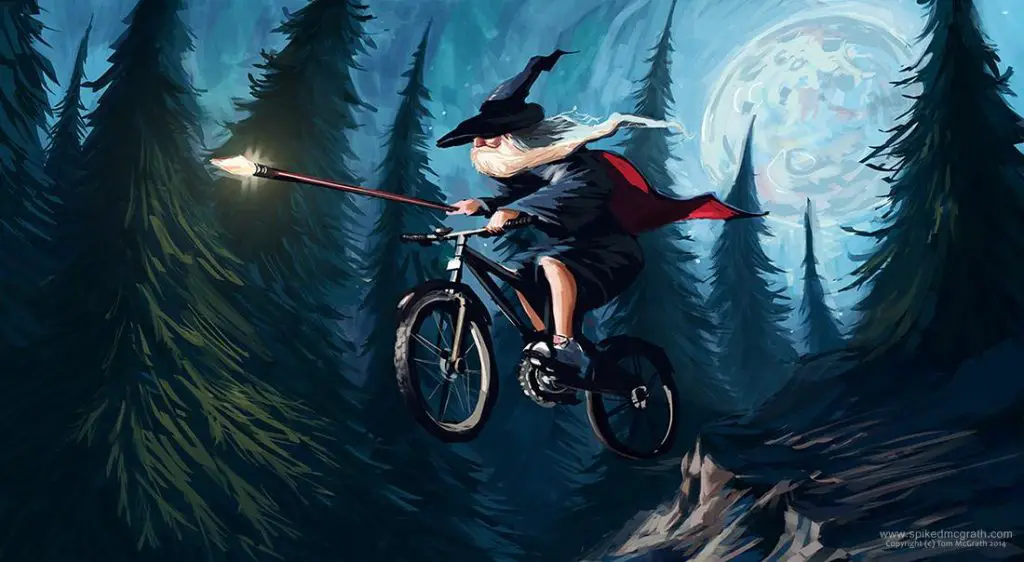Mörk Borg (“Merk Borg’)’ is a doom metal fantasy tabletop roleplaying game by Pelle Nilsson of Ockult Örtmästare Games, Johan Nohr of Stockholm Kartell, and published by Fria Ligan (Free League). The game’s aesthetic feels inspired by Heavy Metal magazines, Mad Max, Ralph Steadman’s artwork, and hyper carnage shows like adult swim’s Metalocalypse and Superjail!. You know this game is metal AF because it’s pronounced in cursive and uses these two dots above this “o.” I mean come on, they commissioned a vinyl album soundtrack of industrial doom metal for an adventure, and then printed that adventure on the cover, which you can use as a GM screen.
Mörk Borg vomits style.
There’s a lot to love about this rules-lite tabletop roleplaying game, but the book can also be a bit hard to follow along with at first glance, because it definitely isn’t laid out like a conventional TTRPG. There’s a barebones version of the game over on their website available completely for free, but once you understand how the game functions and where to find the info, I think you’ll come to love Johan Nohr’s graphic design artistry all over this book. To help out with this, once we get to playing the game, I’ll include the page numbers for where you can find this information on both the full art book and the barebones PDF.
Is Mörk Borg Any Good?
“Out of the box,” Mörk Borg isn’t really the kind of thing that will appeal to everyone. In the default setting of the Dying Lands, you’re playing a doomed character living on the verge of an apocalypse. You won’t be making a 4th level Half Gnome Transmutation Wizard multiclassed 2 levels into Divine Chicken Wrangler Psychowarrior with the Honey Dipper Job. You don’t have a race, you don’t have a background, and classes are optional.
It’s very “all thrills, low frills” in terms of crunch, has a generally smaller palette for character expression, and the overall portfolio of damage, magic, and the super high-fantasy mouthfeel of modern TTRPGs has been stripped down. Magic still exists, but the overall level of magic within the system is akin to a world like Dark Souls or The Witcher, where magic is limited and deadly.
Because of this, creating a character in Mörk Borg can be done in 30 seconds, or a millisecond if you use the scvmbirther website. The developers embraced this and didn’t make fancy character folios; they made a character sheet tear-off pad that they’ve had trouble keeping in stock. If you’re a fan of Ben Milton’s Knave, I think you’ll like what you see here.
What Difficulty Rating Is Mörk Borg?
The overall level of deadliness makes the system feel more like a roguelike TTRPG, as opposed to the epic fantasy campaigns of D&D and Pathfinder. Mörk Borg can suit a long running campaign, but people that want a more involved leveling system with some crunch may be found wanting here.
When you drop to zero hit points, there’s no death saves; you’ve got a 25% chance of just dying–becoming 100% if you take damage dropping you below 0. It’s also not the kind of game that has tons of means of recovering your health or resurrecting fallen allies; if your character dies, it’s time to roll up a new one. That’s not to say this is a “high skill” game with any kind of “get gud” gate-kept mentality. It has an incredibly warm and welcoming community, but the game knows what it’s about.
Additionally, several supplements have dropped that threw the Borg system into other settings. CY_Borg entered the scene November 2022 and has quickly been embraced as a major contender for the definitive cyberpunk TTRPG, Pirate Borg was an incredibly successful Kickstarter that throws the players into a doomed Caribbean of eldritch horror, and just announced this month was “Farewell to Arms”, a World War I inspired Mörk Borg hack that fully funded within 12 minutes.
With my elevator pitch out of the way, let’s walk through how to play this game, assuming you’re at least somewhat familiar with how TTRPGs are played.
How to Make a Mörk Borg Character
The default for creating a PC is a 5 step process:
- Classes (pp. 46–57; BB pp. 46–57): This is an optional rule, but I don’t see many people opt out of it and it feels way quicker to make a character. You can choose a starting Class which will give you set rules for starting wealth, a number of Omens (more on this later), your HP, a short ribbon, your abilities, a load out of equipment, and a unique class-defining feature. If you decide not to start here, you’ll go to page 18, or 21 in the Barebones edition.
- Equipment (pp. 18–25; BB pp. 21-26): You start with 2d6x10 silver (s), a waterskin, and d4 days of food. You then roll for starting equipment using a d6 for a container or vehicle and two separate d12 rolls for additional gear. Then you’ll roll a d10 for a weapon or a d6 if you got a scroll off of one of the d12 rolls earlier. You roll a d4 for starting armor or–like with your weapon–a d2 if you got a scroll earlier. You can spend the silver you rolled earlier at this point to also buy additional gear if you wish.
- Abilities (BB pp. 27): There are 4 Abilities in Mörk Borg; Agility, Presence, Strength, and Toughness. Agility is similar to Dexterity, Presence is a sort of general “Wis/Int/Cha” stat, Strength is Strength, and Toughness is similar to Constitution. You roll 3d6 and can either assign them or roll it straight down the line. Once you have a number, you use this table to determine what the Ability score is, ranging from -3 to +3. If you didn’t take a Class earlier on, you can roll 4d6 and drop the lowest die for two of your Abilities.
- Hit Points ( BB p. 29): Roll 1d8 and add your Toughness to get your Hit Points. You can’t start the game with less than 1 Hit Point.
Is Mörk Borg Easy to Play?
Mörk Borg is a rules lite system. That means it’s definitely easier to pick up than mainstream TTRPG titles like Dungeons and Dragons.
Combat
(aka Violence pp. ; BB pp. 30–32)
Step-by-Step for combat here; Mörk Borg is a “skirmish” initiative system, meaning a party will all act during the same turn in combat against the opposition. This leads to a lot of “war table” style discussion about who should be acting first during the Party’s turn, and gets the group thinking about the actions of the whole team, rather than their lone character.
For “Initiative,” roll a d6. 1-3 the enemies go first, 4-6 the PCs go first.
Mörk Borg is a d20 roll-over system, meaning rolling high is generally the “good thing” you want. If you’ve played D&D or Pathfinder, this is going to feel very similar, but the purpose of these rolls will feel slightly different.
Attacks aren’t made against Armor Class, they are made against a “Test”, meaning players are assumed to hit an enemy on a d20 roll of 12 or higher after adding the appropriate modifier. Think of this more like an “Accuracy Test” rather than an “Attack Roll.” Melee adds Strength to this roll, Ranged adds Presence.
Enemies on the other hand, are assumed to hit unless Players succeed on a Defense Test of–typically–12. Think of this like they’re always making saving throws. This helps to speed up combat, keep the focus on the player character, and engage the players themselves during the enemy turn.
Armor no longer makes enemies less accurate, it makes them less lethal. Armor reduces damage by an indicated die.
If you noticed there; this means the GM isn’t making d20 rolls in combat for the most part.
Scrolls
“Scroll” more or less means “Spell” in Mörk Borg. You gain Scrolls that unlock Powers for your character. You get a number of “spell slots” for the day each morning equal to 1d4 + your Presence. When you activate one of these Scrolls, you test your Presence and if you roll a 12 or higher on the d20 after adding your Presence, you successfully cast the spell and subtract that use. If you fail, you lose some HP and can’t use these powers for an hour.
Roleplay
Most everything here is handled by your equipment loadout, personal flair you’re inspired to throw on the character, and maybe some ability rolls. There are totally free subsystems for things like Travel should your group decide to engage with them, but that’s all optional.
At this point, it’s basically like playing any other TTRPG. There’s additional rules involved that are mostly GM-facing, but this should give you the knowledge of how to interact with a Mörk Borg game to the point of knowing what’s happening if you check out an Actual Play.
Final Mörk Borg Review
In some ways, I feel Mörk Borg is easier to grok than most modern TTRPG systems. Despite how easy systems like Dungeons & Dragons and Pathfinder may be after you learn them, their crunchiness presents an undeniable barrier for entry. Mörk Borg provides snappy, brutal combat that cuts most of the subsystem support out in favor of hitting hard with practical rules. That’s not to say those subsystems don’t exist in an officially-supported manner, they just aren’t present in the core rules.
One of the jokes I’ve heard in 3PP circles is that “Mörk Borg has more designers than players” and… I kind of see it? The 3PP scene for Mörk Borg is massive due to how simple the game is to get into. As a 5e 3PP myself, I totally understand why: Mörk Borg is incredibly easy to create content for. A brand new class option can be created overnight, they encourage short-form 5-room dungeon style adventures to plug into the game that can be written in a weekend, they encourage there’s just a lot to be said for how appealing the system is to write for. In general, if you’re looking for a fun “beer and pretzels” style romp to get a break from epic high-fantasy and sci-fi campaigns, Mörk Borg is a fantastic change of pace. It’s content may not be for everyone, but for those that it is for, it’s their principal system.
Want to read more from Taron Pounds? Read more of Taron’s guides and reviews right here.




